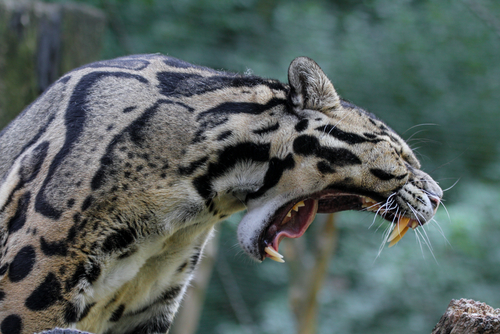
The clouded leopard is one of the most adorable predators in the world, but unfortunately, they are also one of the most poached.
Basics
- The clouded leopard is found in Asia, from the himalayas to Southeast Asia.
- Their habitats are getting smaller and more fragmented, which makes them vulnerable to extinction
- The number of mature individuals has decreased by about 30% in the past three generations.

- Hunting has also taken a huge toll in their numbers.
- There are protections in many countries that work to preserve the species by making it illegal to buy and sell such products. However, illegal poaching still occurs.
- There are currently less than 10,000 clouded leopards in the wild.
- There are two species of clouded leopard: The clouded leopard (neofelis nebulosa), which lives in the mainland, and the Sunda clouded leopard (neofelis diardi), which lives in the islands of Borneo and Sumatra.
- Until 2006 they were considered to be the same species, but genetic analysis have shown that they’re distinct species.
- They are the smallest of the big cats. But there is a bit of controversy about what it means to be a “big cat”
- Some people say they are all the members of the panthera family (snow leopards, leopards, jaguars, tigers, and lions).
- Others say its the only members of the panthera family that can roar (all them except snow leopard)
Biology
- Clouded Leopards are medium sized cats.
- Males can weigh up to 16 Kg and females 13. Although some sources say they can get to be 23 kg.
- Their coats has distinctive cloud-shaped markings, which gives then their name.
- Their canine teeth are huge. They have the largest canine proportional to body size of any wild cat. They can measure up to 4 cm. They’re like little sabre-tooth tigers.
- Their tails are also very long—it helps them jump and provides balance when they jump from tree to tree in the forests they inhabit.
- They’re mostly found in Evergreen tropical forests but are also found in dry and deciduous forests.
- They can live at altitude of up to 3000m.
- Like fosas and squirrels, clouded leopards have rotating ankles that allow them to climb down head first, which is helpful when their stalking arboreal prey. They can even hang from their hind legs.
- Clouded leopards can also climb horizontally with their backs to the ground
 Photo by jdross75
Photo by jdross75
- Clouded leopards are just over two years old when they begin reproducing.
- During mating, the male will bite the female’s neck and she will make noises to encourage him to continue.
- Due to their large canines, accidents can happen and there have been reports of males killing females by breaking their necks
- After about 3 months of pregnancy, the female will give birth to 1 to 5 kittens, who are blind and helpless. At birth they weigh at most 250 grams.
- Kittens open their eyes at about 10 days, they start playing at 5 weeks, and are fully weaned at 3 months.
- Females can have one litter a year.
- Males rarely help raise the children.
Behaviour
- A study in Thailand showed that clouded leopards catch prey both in trees and on the ground
- The most common prey were hog deer, slow lorises, porcupines, pangolins, monkeys, and ground squirrels.
- Clouded leopards will establish ranges of about 30-40 squared km, but will have a main area of 3 to 5 squared km, where they hunt more intensively.

- Female and male ranges overlap, which is not strange for cats, but even male’s ranges can overlap quite a bit, in some cases up to 40%.
- Clouded leopards will occur in higher densities when they don’t have to compete for resources with bigger cats such as tigers and leopards.
- They can be vocal and have a wide range of noises: mewing, hissing, growling, moaning, snorting, etc.


